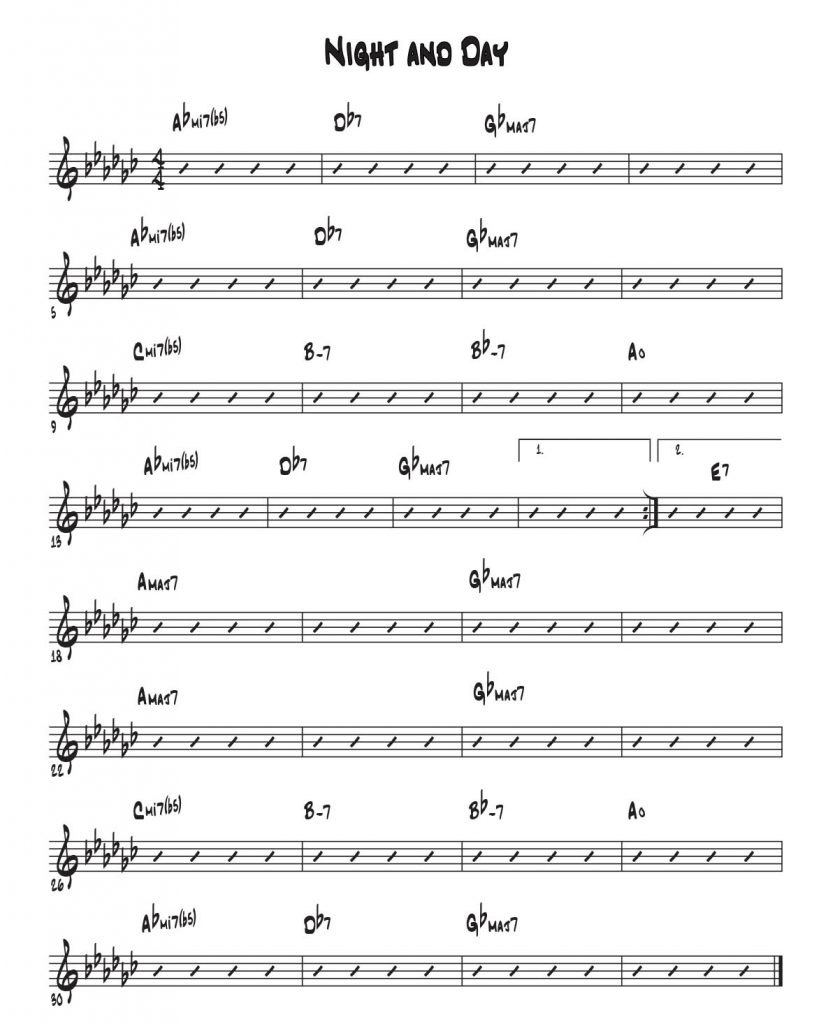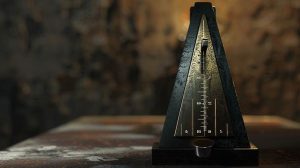
The Benefits of the Ear to Instrument Connection
I recently watched a video performance by the amazing classical pianist Yuja Chang. I’ve seen her memorizing motion and heard her virtuosic playing before, but something hit me after seeing
Categories:
Categories:
Learning to play jazz starts with the exploration of chords. You learn D minor to G7 to C major and all sorts of permutations of that progression and many others.
Once you learn the theory of chords, you improvise over them using scales that are associated with each chord. Dorian, Mixolydian, Locrian, Diminished, Blues, and on and on.
So it’s only natural that when you improvise over a tune, you read the lead sheet. The more experienced you are, the better able you are at ‘reading’ the chords on the page and translating them into improvised lines. Even if you’ve memorized the melody, you probably think of the chords and scales.
But at a certain point, many players who learned this way discover a problem. Their translation of chords into scales limits what they play. The sound like scale runners, or at least their melodic lines aren’t so spontaneously melodic while they stumble from chord to chord and key to key.
And there’s another problem, but this is one they may not be aware of.
The translation of certain chords and keys into scales or patterns creates a type of friction. Quick: how many flats are there in the key of Gb minor? Or sharps in the key of B Lydian?
The mental hurdle of translating those types of more difficult keys slows down the improvisation process. The problem is that you are using your eyes and analytical brain to create music which is an aural art form.
What is the answer? USE YOUR EARS.
Ahh, but now you’ll reply, “I have to look at the chords in order to know what to play.” If that is your initial reaction, I want to give you an ah-ha moment.
If I asked you to play over the standard tune Night and Day and do so in the key of Gb, you’ll ask for the chord changes. Here they are:

As your eyes glaze over Ab minor 7 b5 or Gb major 7, you may realize that watching these chords fly by isn’t all that helpful.
Let’s try an experiment. Below are three choruses of a rhythm track to Night and Day in the above key. Play the track and before touching your instrument, I want you to simply sing the melody. No instrument. Your voice knows no difficult keys.
Of course, this assumes your know the melody, but it is a very standard tune that you should at some point know.
Once the sound of the melody and key gets sufficiently into your ear, I want you to simply play the melody. Don’t do any real-time translation or mental gymnastics, just listen and play the melody.
After you can easily play through the melody, it’s time to jump into some improvisation. Now, here’s the hard part, especially if you’re someone who relies on the written page. DO NOT think about the key or chords. Just listen. If/when you get stuck, stop playing and sing. Maybe sing some improvisation first.
Your improvisation need not be complicated. Just some nice lines. The point to this exercise is to prove to yourself that your ear can guide you much better than your eyes.
What? You think I’m wrong?
If you feel that way, maybe it’s because your dependence on your eyes and calculating brain has become so ingrained that you can’t let go of it? Is that possible?
Don’t give up on this exercise quite yet. Let me give you a hack. The hack is to abandon caring so much about right versus wrong notes. In fact, this exercise is a win if all you do is focus your brain on listening to the rhythm track and your instrument regardless of what comes out.
You’re not performing Night and Day at Carnegie Hall. You are practicing it by yourself in the comfort and security of a solitary non-judgemental space.
Sing the melody, then play the melody, then sing some improvised lines, then play some improvised line without a care in the world about the key. The celebrate that you can play over Night and Day in Gb!!!
Let me know your results in the comments below!

Trombonist, author, marketer, & tech guy
Share this post…

I recently watched a video performance by the amazing classical pianist Yuja Chang. I’ve seen her memorizing motion and heard her virtuosic playing before, but something hit me after seeing

I have created a AI chatbot called Jazz Master Chat that draws from 75 hours of interviews from my Jazz Master Summit event a couple of years ago. I interviewed

What is jazz improvisation? Let’s first define what I mean by jazz improvisation. Jazz improvisation is a spontaneous conversation, but instead of words, we use notes. Look at two possible

My recently turned 18-year old son is a passionate photographer. He’s got himself a little business where people pay

A couple weeks ago I sent Richie Beirach a YouTube clip from the movie Whiplash as a bit of

I originally meant to write this as a reply to a comment Richie Beirach wrote on my blog. But

Tools for helping musicians at all levels learn about jazz and play to their full capability.
Web design and marketing by:
Michael Lake @JazzDigitalMarketing.com
This is just a fake book example for the type of website I can build for you. Just trying to use a little humor here!
2 thoughts on “Does staring at chords help you improvise better?”
Thank you. I love Cole Porter, but wasn’t very familiar with the tune and had to look it up, but once I tried it, I think it went better because of my experience working through the Jazz Patterns for Ear book by Michael Lake. I used to say that I was no good at playing by ear. Turns out I can get better if I give myself permission to try. Great resources!
Judy, I think MANY people could be better at playing by ear than they allow themselves. The problem they run into is that they were taught music by using their eyes and calculating brain rather than listening and reacting to the sounds they hear around them. Glad to hear that my Patterns for Ear is helping you in this regard.